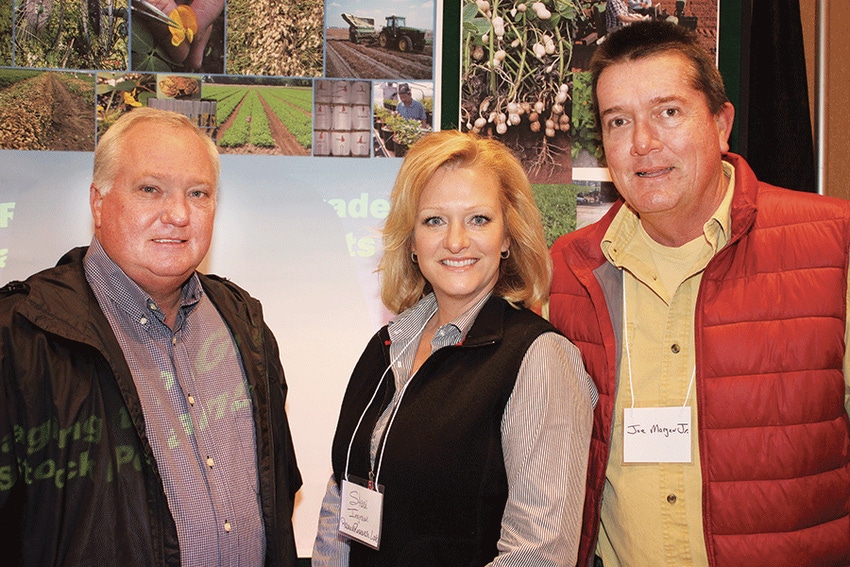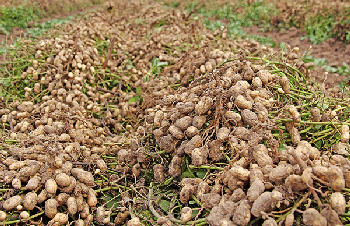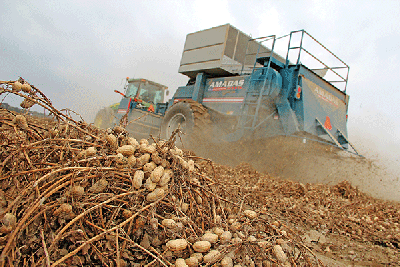
Because peanuts now offer the most attractive economic potential compared to other crops such as corn, soybeans, or cotton, those who can grow the crop are likely to increase acres this year, says Marshall Lamb, research leader at the National Peanut Research Laboratory, Dawson, Ga. He spoke at the annual meeting of the Mississippi Peanut Growers Association.

With almost three-fourths of the U.S. peanut crop concentrated in a relatively small area of three Southeast states, producers are going to have to learn to live with production and price volatility, says Marshall Lamb, research leader at the USDA/ARS National Peanut Research Laboratory at Dawson, Ga.
“If you look at a map of the southern states, there is a cone-shaped area from Mobile, Ala., that goes across to Savannah, Ga., and back. In 2012, that area represented 73 percent of all U.S. peanut production. When you have that much of a commodity produced in that small a geographic area, drought like we had in 2011 can have a tremendous impact. A good weather year like 2012 can have the opposite effect.”

EVEN THOUGH peanuts are in oversupply, farmers may plant more acres this year because other crop prices aren't competitive for acres.
And because peanuts now offer the most attractive economic potential compared to other crops such as corn, soybeans, or cotton, he says, those who can grow the crop are likely to increase acres this year — and that could could result in a big carryover that could depress prices in 2016.
"The reality is that the U.S. is oversupplied with peanuts right now,” he said at the annual meeting of the Mississippi Peanut Growers Association at Hattiesburg.
“Crops that would otherwise be competing for acres are all down in price. You would think with the kind of carryout we had in 2014 that we’d be looking at a reduction in peanut acreage this year, but instead I think we’ll see an increase. The big question is, how much increase?”
Stay current on what’s happening in Mid-South agriculture: Subscribe to Delta Farm Press Daily
The peanut market, Lamb says, “is basically a roller coaster ride, with a history of ups and downs — good prices that spur acreage increases, followed by oversupply that results in lower prices and acreage cutbacks.
“That scenario is going to be difficult to change, and growers are going to have to get accustomed to it and learn to manage it.” The current large carryover illustrates the seesaw picture of U.S. peanut production, he says.
“In 2011, we had one of our shortest, poorest quality crops, largely due to drought in Texas and the Southeast, which resulted in only 380,000 farmer stock tons of carryout. The carryout number I like to see is about 500,000 farmer stock tons, which is what is needed to keep mills and shelling plants running in August, September, and October until new crop deliveries start coming in.
Big carryout impacts price
“Our U.S. plants can shell about 165,000 tons per month, and in that three-month period we can basically clear the carryout before new crop deliveries come in. Anything less than 500,000 tons, and manufacturers and shellers start worrying about supply interruptions, while anything significantly above that number adversely impacts price at the farmer level.”
With the abnormally low carryout in 2011, Lamb notes, “Uncontracted peanuts reached about $1,000 per ton at the end of the year, and farmers who were able to take advantage of that did quite well. This gave price signals going into 2012 that we needed to expand acreage.

PEANUTS are now by far the most attractive crop from a price standpoint, says Marshall Lamb.
“In 2012, we had contract prices of roughly $700 per ton early in the year — and growers planted a lot more peanuts. The Lord blessed us with good rainfall and weather, and we produced our highest yield ever (4,217 pounds per acre) and the largest production ever of 3.4 million farmer stock tons.
“We ended 2012, with 1.2 million farmer stock tons carryout — almost a three- to four-fold increase in just one year. That sent a major dampening signal to the market, with much lower contract offers to farmers in 2013. Even with lower acreage, we carried over about 930,000 tons from 2013 into 2014. Then we produced 2.6 million tons in 2014, and ended the year with almost the same carryout as 2013.
"In 2014, our production basically equaled the entire demand for the U.S. I was hoping there would be enough increase in demand to bring the carryout down, but we didn’t see that.”
Given the size of the 2014 carryout, Lamb says, the question now is: “How much production will there be in 2015 and how will it affect us?”
Using various acreage and yield factors, it’s possible, he says, to develop scenarios for 2015 and 2016.
“If we have a 20 percent increase in acreage in 2015 over 2014, with yield roughly the same as the past few years, and demand stays the same, we’d have anywhere from 1.2 to 1.4 million farmer stock tons carryout going into 2016.
“That wouldn’t be a good story for us. We’d be grossly oversupplied and prices might stay depressed into 2016.”
With an 800,000 to 1 million ton carryout, Lamb says, “We’d still be in an oversupply situation, but it would be correctable in 2016. What’s really needed to correct our oversupply situation is for other crop prices to compete for acres. But right now, peanuts are by far the most attractive crop we have from a price standpoint.
Increase in exports needed
“If we have some geographic crop setback due to drought or other conditions, markets could tighten significantly and we’d see buyers coming back into the market in a hurry. But that would stimulate more acres and bring even more oversupply.
“ If we can get into more export markets, that would open up tremendous opportunities for us to increase demand and get rid of some of these peanuts. A lot of work is going on by the National Peanut Council, the National Peanut Board, the Peanut Institute, and other peanut organizations to boost demand.”
One bright spot now, Lamb says, is China, which in the last two months has “come strongly back into the U.S. market.
“We have the highest quality peanuts in the world on the market now, and they’re at the lowest price compared to other origins. This is partly because of crop problems in Argentina, but it’s more due to significant problems of quality and quantity in the Chinese and India crop.

MORE EXPORTS would open "tremendous opportunities" to a increase demand and reduce the current oversupply.
“In 2012, we exported about 170,000 metric tons of peanuts; in 2013, that rose significantly to 400,000 metric tons. From January through September 2014, we exported 328,000 metric tons, and when totals for the year are in, there’s no doubt we’re going to blow through the mark that was set in 2013, exporting more than 400,000 tons.
“This is very encouraging. The export market has become a very significant part of our sales, and a good opportunity to get into, and stay in, the international market.”
Mississippi’s importance in the peanut industry is increasing every year, Lamb says. “With the ongoing decline of the Ogallala Aquifer in West Texas, which has led to a significant decline in their peanut production, we need new areas, with fresh ground coming into production, so we can expand peanut consumption in the U.S. and worldwide.
“Southern peanut farmers are an integral part of U.S. agriculture. The added income stability that is provided for peanuts in past and current farm bills is critical to our producers.
“When our leaders went to Washington and came back with the current farm bill, they didn’t just come back with more income protection for peanut producers than other commodities got, I think they came back with more income protection than they really expected to get through the generic base on peanuts.
“The effectiveness of southern peanut farmers and their organizations and lobbying effort in Washington has been incredible,” Lamb says, “particularly given the size of the crop in relation to other commodities.
About the Author(s)
You May Also Like



